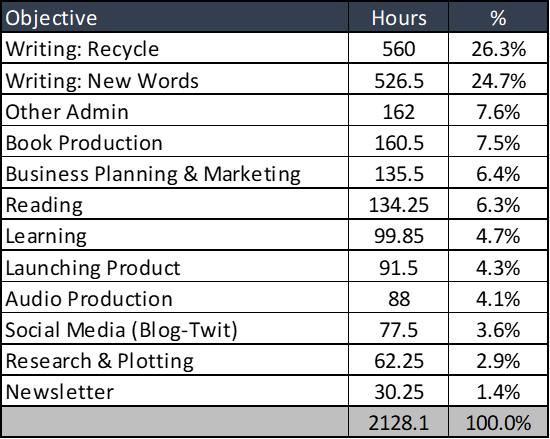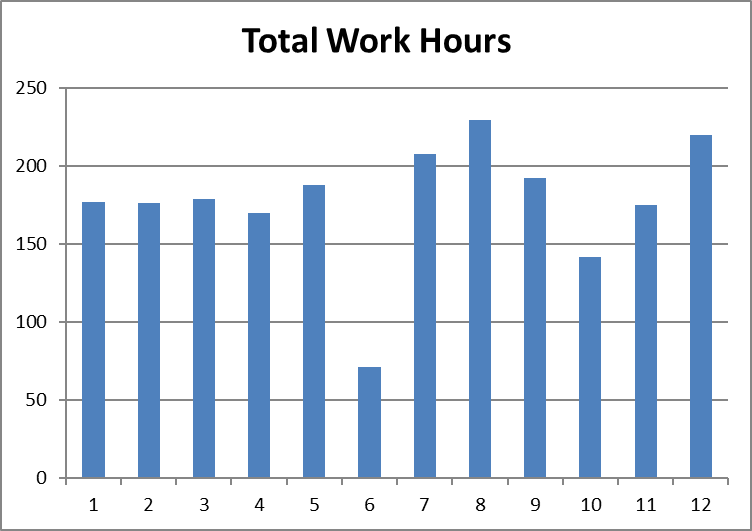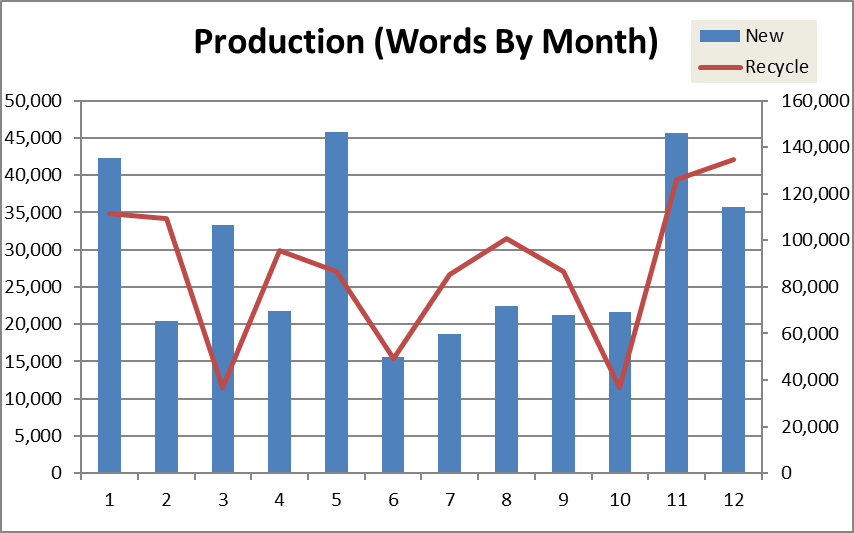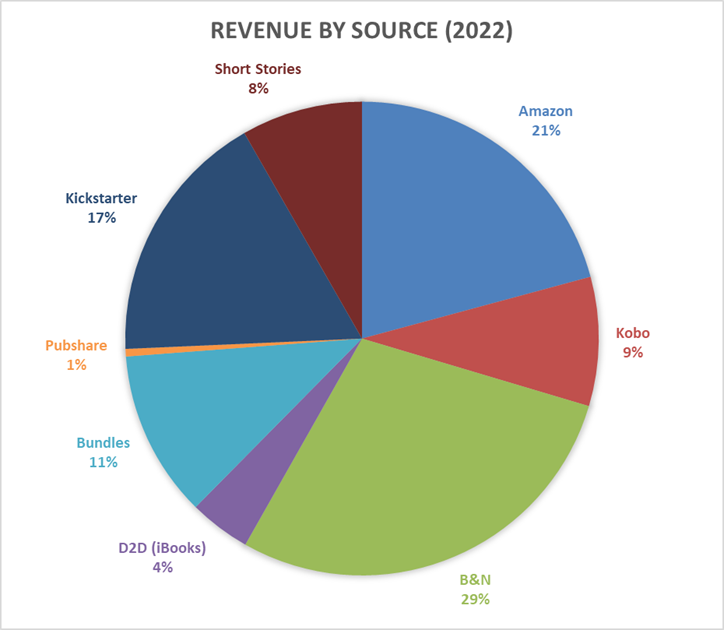This is a “Let’s Look Back” post, but I hope it’s a bit different from most (he says poetically). If you’re not interested in the inner workings of a full-time, independently published writer, you might want to move along. However, if you are interested, then strap in and see where this goes. Maybe there will be something in it for you.
There was a lot going on in the Collins household this year. Arguably, the big event on the life side of the equation was that we decided mid-year to pick up and move from Tucson to Las Vegas. That has gone well. We’re much more active and physically fit, never mind the groaning and moaning. That’s just me getting too old. Having decided to make it officially permanent, we have more to do this spring, but that’s life.
Relative to the past few years, my writing life pretty much exploded, which is good.
And it hasn’t stopped much. There’s a lot going on now, too. Perhaps the next rock will be a “Let’s Look Forward” kind of post, but right now I want to focus on the past year.
To be upfront here, one key point for me is that 2020 was a tough one, but I mostly fought through it in parts. 2021, though, was quite dead until October, and it’s fair to say I wasn’t running along well until later—say December. I made some personal life decisions that shut things down for much of the year. So, in the reality of my world, while 2022 looks great, I want to remember that it was a major comeback year. Life is never all roses. And I’m sure I could do a lot better. Lots of others do, anyway—not that I want to compare.
You’ll see this in some numbers I’ll be posting.
That’s a thing about the life of writers in general—and particularly those focused on the independent side of things. When the world we live in takes a turn, there’s no one else around to keep the wheels on. Variable output is the norm.
If you know me, you know I can be the slightest bit obnoxious about tracking and measuring things. My writing is no different. This means I’ve got a metric crap-ton of information about how I work and what I’ve accomplished. That’s a way of saying that this is going to be a long post, and I’ll cover a lot of ground. Word count? Yes. Stories and books published? Of course. But there’s going to be a lot more than that here. I’m going to be breaking down what it means to be an independently published writer, focusing down there where the rubber meets the road. I’m going to talk about how I spend my time and what that means, where I sell my work and what that means. Unless you’re an indie writer (or a masochist … is there a difference?) this may bore you to tears. If nothing else, I’ll be documenting it for myself, but I hope it will give folks some idea of what I’m doing.
I suppose it will also say something about my choices and maybe even what I’m missing out on. Feel free to judge me silently.
So, all right. Um, where shall I start?
Let’s do it this way:
Raw Word Count:
I track words in two ways: new words and “recycle” words. I explained this in a chapter of On Writing (And Reading!) Short:
I find it fascinating how many ways lifetime writers find to count words. And, yes, I do it too. I am a writer after all. My own fashion, these days, is to split my count into “New Words” and “Recycled Words.” For example, this chapter is just north of 1,000 words—so when I wrote the first draft, I credited myself with 1,000 new words, but when I did my second pass, I credited them as 1,000 recycled words. I do this to remind myself that I want to be creating words fresh—and I’ve learned I need to hold myself accountable in that fashion. Other writers have different psychological needs, I guess. There is no wrong way. Just remember, though, the real point is still to get works done, not just words.
My 2022 numbers:
New Words: 344,275
Recycled Words: 1,059,180
There are a few ways to look at this. First, I averaged just under 1,000 new words a day. Second, one could look at this and say that I average four passes on any work (340K new, then three times that in recycling). That’s maybe fair, but I should note that many of those recycled words happen in the middle of the first draft—meaning that I go back over things while still in process, smoothing as I go.
In practice I’d say I average essentially three drafts before something is ready: one to get it down, one to fix it up, and one after beta readers have a shot at it. On occasion Lisa (in the copy editor’s anchor seat) has gently let me know something isn’t quite baked at that point, and I’ve done another.
Three passes seem about usual, though, and I think this data supports that.
Hours Spent: (writing vs. all the rest)
The great thing about being an independently published writer is that it’s all me. If people like anything about my work, it’s because of me. If they don’t it’s because of me. I have always “contracted” copy editing to Lisa. And I have contracted out covers in the past, but since my Saga of the God-Touched Mage days I’ve done them all for myself.
I write the books. Lisa edits them, but I have the final say over anything that goes in, and if errors occur, I’m sure it’s because I’ve inserted them somewhere down the path. I design the books. I write the interstitial material. I do the covers. I manage the publication process. I build the books. I review the proofs, and I release them to distributors. I decide pricing and launch schedules. I write the newsletters, I run the promotions and fiddle with whatever advertising the books get.
So, yeah. The buck stops here.
Not that this is particularly different for anyone else in this stream of the lake.
That means there’s a lot more to my days than staring at the walls and throwing down words.
Here’s how my year broke down in 2022:
Given that the standard work year was considered 2,080 hours when I was working in Corporate America, I managed to edge a bit over that (2,128). I’m sure I’m under-reporting the time I’ve spent both keeping my social media presence up (such that it is), and the time I spend reading (which I count as a writing objective because I think it’s important).
I’m happy with this number. It means I’m putting in the time.
I’m pleased at the general breakout across objectives, too. I focused on the creation of words about half my time (51%), and that time was split about evenly between creating new words and going over later drafts. I’d like it to be a little more, but that’s not bad.
I’m sure there’s some overlap between “other admin” and “learning.” Both can be catch-all categories that can include anything from reading relevant updates from around the industry, to one-on-one conversations that were particularly thought provoking, to hands-on learning about a new tool. I’m not trying to be particularly precise here. No one needs to see this stuff but me.
I’m also looking at the chart and thinking about how I can restructure things in 2023.
Specifically, right now, I am thinking about tools.
For example, I spent 160 hours last year designing books. I still do this in Word and with Jutoh, so I’m strongly thinking about the value of spending money to upgrade to Vellum (I tried Atticus last year and wasn’t comfortable with it). If Vellum cuts my production time in half, then that would save me 80 hours of work that I could then use in other ways.
Launching Product is another interesting line item. I am a “Wide” author, meaning that I sell direct on most platforms. Specifically, when I launch a new book I put it on Amazon, Barnes & Noble, Kobo, and GooglePlay directly, then I reach iBooks and some others through Draft2Digital. This line item is expressly the time I spend in front of the screen, pushing buttons and filling out information on all those sites as I publish and/or update my catalog. It also includes things like the mind-numbing hours it can take to change your danged pricing across them all.
These tasks cost me 91 hours last year. Over two full work weeks.
Please, God, if you ever decide to prove you exist, make this easier (hey, it’s worth a shot).
Sustainability:
If you’re like me, when you think about a “process,” you think about it like you should be a machine. Sit down, crank out X words per day. That is me, but not me. My process is all over the map. And given that I don’t punch a clock, my work schedule can slew all over, too.
Here are two charts to prove that.
First, work hours by month:
Notice June? That was the month in preparation of our move. See October (and to a lesser extent, November)? That’s what three weekend trips to Tucson will do.
Take those two away, though, and you’ve got a pretty good story about consistently coming to the table. That’s the key to this thing, I think. Whatever your pace is, bring yourself to it. I’m happy here.
Now let’s look at this one:
Here is a chart that shows the real variability of my creative process. Even though my butt hit the seat pretty consistently, my word count numbers are all over the map. The “New Words” are plotted against the values on the left of the chart, “Recycled Words” against the right side.
Note how much my numbers vary from month to month. I point to this because if you’re like me you might get a little cranky in the middle of those down months because you’re thinking that you really should be getting more done. I admit I don’t love those 20K months. That’s only about 700 words a day on average. But they are decisions I’m making for apportioning my time. I could write more and publish less, for example. I’ve got the breakout by week, too, and it’s even more chaotic. This data shows that when I decide to focus more on creating words, and less on the publishing business, I finished at 45K/month.
To be honest, I think that’s too low for a peak, but I’ll take it for now.
I say that because…well…I got a lot done.
How much?
Let’s look.
Work & Milestones Accomplished
Stealing the Sun series:
Finished and Published Stargames, Book 7
Wrote and Published Stardust, Book 8
Wrote and Published Starborn, Book 9
On the coattails of a good BookBub event, Starflight (Book 1) was on Amazon and Barnes & Nobles’ bestselling lists for some time.
Published the STS Book 1-3 Boxed Set
Published the STS Book 4-6 Boxed Set
Wrote and Published Starcruise, a stand-alone short story in the STS universe (Have Ship, Will Travel)
Collins Creek Collections:
Published Contemporary Currents and Historical Eddies, Volume 1
Published Streams of Speculation, Volume 2
Published Tides of Adventure, Volume 3
Published Omnibus Boxed Set
On Writing (And Reading!) Short:
Wrote and Published the book
Released it via a successful Kickstarter
Final release set for pre-order (publication date Jan 30)
Miscellaneous Publishing Things:
Released Five Magics with a new cover
Released “Deca-Dad” (a short story) as my first audio book
Short Stories:
Wrote and Published “She Wanted it to be Perfect” (WMG’s Holiday Spectacular)
Wrote and Published “Life’s Little Pranks” (Valdemar Anthology)
Published “Companion” (Analog)
Published “Day of the Party” (Fiction River, Broken Dreams)
Published: “Machine” (Boundary Shock Quarterly #17)
Wrote and Published “Battle Buddies” (Boundary Shock Quarterly #18)
Wrote and Published “The Sea’s Cold Equations” (Boundary Shock Quarterly #19)
Wrote and Published “King of Gods” (Boundary Shock Quarterly #20)
Published “The Lunar Council Cares” (Pulphouse)
Published “A Corner of the Mind” (Pulphouse, reprint)
Novelettes:
Wrote “Paradox on the HMS Observant” (with Brigid Collins!) To be published, (Boundary Shock Quarterly #21, Jan 2023)
Works Written in 2022, but Still In Production for Next Year:
The Intergalactic Band of Brilliance (short story, with Jeff Collins)
Happiest Place In Space (or Happy Family Fun): Cruise Brothers Book 1 (with Jeff Collins)
Home Run Enchanted, Fastballs and Fairies, Book 1 (with Brigid Collins)
Realm City (Book 1)
Three short stories (out at markets)
I’m sure I’ve missed something somewhere. But you can see that 2022 was a big year, both on the production side and the raw publication side. I wrote six books and pushed a lot of other books and stories through the pipeline. Some of it was back list, which is good. I need to do better with that.
How Wide is Wide?
Without going into specifics, I’ll note that in 2022 I was a low 5-figure author. Not great. Not horrible. Given that I’m essentially coming back from two very slow years, I am happy with my numbers.
As I noted before, I’m a Wide author, meaning that I put my books in all sorts of places rather than focusing totally on Amazon. Until 2022, Amazon was still my number one source of sales revenue, but that is not the case now.
My pie chart looks like this:
Items of note:
- As I said up top, Barnes and Noble, not Amazon, was my top revenue source in 2022. This surprised me because it generally has never even been #2 in past years. That said, they have been aggressive in helping my work at times. I’m hoping to build more here next year.
- With the aid of a BookBub, Starflight (book one of my Stealing the Sun series) hit number 1 in several categories on both Amazon and Barnes and Noble. I’m guessing that’s true of Kobo, but I’m not sure. This boosted Amazon numbers quite a bit but also carried weight across the whole set of online retailers.
- In addition, 2022 saw me add Amazon ads to my toolbox. I’m not particularly aggressive with them, but I’ve seen slow, steady value so I expect that to continue.
- I was happy with my foray into Kickstarter. The project was a lot of fun. It also resulted in a good chunk of my annual revenue (17%). Definitely working to improve on that in the future.
- Similarly, I had two opportunities to participate in story bundles, and that made up 11% of my intake.
- Despite being only 9% of my revenue source, the raw 2022 Kobo sales numbers are about double what they were last year. But then, last year was a tough year, remember?
- Then there is stand-alone short fiction published through traditional means. I have a great time with them, and they represented 8% of my revenue.
- I should also make a note that late 2022 is the first time I put work onto GooglePlay. To date it has not been successful enough to warrant a place on the chart. Maybe next year, right?
It’s important to note that a pie chart is always constrained to 100%. This means that an increase in one category over time can make the rest look bad. My success on Barnes & Noble is a good example. As with Kobo, my numbers on Amazon were considerably better in 2022 than 2021, but this data shows they shrunk. Instead, what has actually happened was that the pie itself got bigger. Which is the goal.
That said, I would certainly like to gain more traction in both GooglePlay and D2D (which for me is mostly iBooks). I also intend to use Kickstarter more often if my project supports that idea.
The Cost Side
I haven’t made a fancy chart, but in 2022 I categorized my business expense side into three buckets:
- Learning/Education (Workshops and travel)
- Promotion (BookBub, Ads, Promotions)
- Operations (Other stuff, Kickstarter Fulfillment)
My expenditures in each of these were roughly equivalent in 2022.
Summary:
As noted, 2022 was a good year. That comes out loud and clear. Production was beyond solid, and, while I’m not exactly basking in millions of freshly minted bills, the business and financial side of my life saw a good step forward.
But the reason I track things this way—beyond the fact that it’s a good accountability tool—is that at this time of the cycle I can quickly look back and ask myself good business questions.
Questions like:
- Is my employee (the writer me) coming to work?
- Am I accomplishing what I want to accomplish?
- What trials worked? Which didn’t?
- How did they work?
- What would I like to see happen differently?
- What changes do I need to make to have those differences happen?
And others, of course.
So that’s what I’m doing.
I’m only showing you a drop in the bucket, really. The key here, regardless of whether the year was good or bad, is to focus on what happens next.
Which, of course, I suggest is good for all of us.




